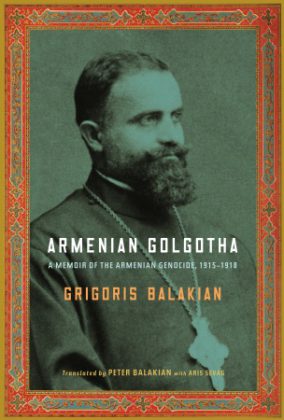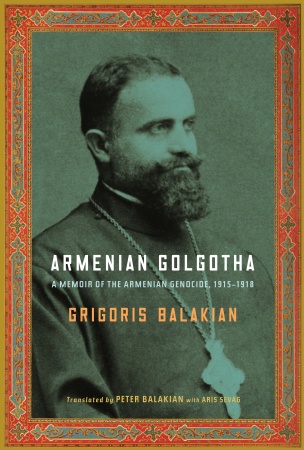

By Chris Bohjalian
ARMENIAN GOLGOTHA
By Grigoris Balakian
Translated by Peter Balakian with Aris Sevag
Knopf. 509 pp. $35
Last month, while I was visiting my father in Florida, we had dinner one night with my aunt. We were discussing the way Jim Jones had poisoned 900 of his followers with cyanide-laced Flavor Aid in 1978, and suddenly my aunt was explaining that another way to poison someone is with a yogurt smoothie. “That's how the Turks poisoned your grandmother's classmates in Constantinople in 1915,” she said. “They poisoned the tahn.”
This story was new to me, and I am 47. But as a second-generation Armenian American, I've found that it's not uncommon for one of these UFO horror stories to materialize out of nowhere over coffee. My childhood was a combination of suburban clich? and Middle Eastern exoticism. Although most of my boyhood in New York's Westchester County revolved around Little League baseball, “Star Trek” and coveting my older brother's record collection, there was also the powerfully alien aura cast by my grandparents, Leo and Haigoohi (pronounced Hi-Gui) Bohjalian. They emigrated to the United States from Paris in 1927, though both had been born near Constantinople just after the turn of the last century. I saw them weekly, either at our home (a development Colonial) or theirs (a three-story brick house that in my memory is a mansion, but that I imagine would strike me as rather modest if I were to revisit it now).
My grandparents spoke a strange language, the characters that formed the words in their books were impenetrable, and my grandfather used to wear a suit with a vest, even on Saturday afternoons. He would play his beloved oud for hours. Their sheer foreignness drove my father crazy, and he worked hard to be more American than a Ford motor plant. In hindsight, I shouldn't be surprised that he entered one of the more iconic American professions of the middle part of the 20th century: advertising.
But there was also something tragic about Leo and Haigoohi. Though no one ever told me the precise circumstances, I knew that three of their four parents had died in the genocide of 1915, and Leo — who had left Turkey — went back after World War I to find Haigoohi. Sometimes I was told that she had been hidden by a Muslim family, other times that she had found shelter in a convent.
Still, my father never spoke of what may have happened to his ancestors in 1915, and as a boy I never asked. And so their story emerges in unexpected, fitful thunderstorms — such as my aunt's yogurt smoothie story last month.
Now, in a powerful memoir being published for the first time in English, I may finally be getting an inkling of what Leo and Haigoohi's parents endured in the Armenian nightmare of 1915-16. Originally published in 1922, “Armenian Golgotha” is Father Grigoris Balakian's account of his deportation from Constantinople with 250 other Armenian intellectual and political leaders on April 24, 1915 — now Armenian Genocide Remembrance Day — and the cruelties he endured over the next three years as he struggled to survive. Roughly 1.2 million Armenians would either be slaughtered by Turkish killing squads or would die of exposure or starve to death in camps in the deserts at the southeastern edges of the Ottoman Empire. Balakian was a great-uncle of the poet and memoirist Peter Balakian, who translated this account with Aris Sevag.
The book presents a litany of barbaric savageries: the mobile killing squads (chetes) of pardoned Turkish criminals; the endless caravans of starving women and children; the grisly decapitations and dismemberments of unarmed Armenians by frenzied mobs using “axes, hatchets, shovels, and pitchforks.” Balakian shares it all in a tone that vacillates between reportorial numbness and a grim determination to live to tell the world what he has witnessed: “On our second day . . . we saw, in the fields on both sides of the road, the first decomposed human skeletons and even more skulls, long hair still attached to them, leaving no doubt that they belonged to females. Among our companions were young Armenian intellectuals . . . . They often bent down to pick up the skulls and kiss them.”
When Balakian asks the Turkish captain guarding them why the victims hadn't been buried, he's informed that they had been tossed into a mass grave, but the winter floods had washed away the dirt. Then the captain adds offhandedly that these were the bones of some of the 86,000 Armenians who had been “put on this road so that we could cleanse them.” (The word “cleanse” as a euphemism for genocide appears often in the text, as does the word “jihad,” giving the account an eerie and disturbing contemporaneousness.)
Balakian eventually escapes from the caravan, using his fluency in German to pass in a variety of guises, including that of a German engineer.
In addition to being a poignant, often harrowing story about the resiliency of the human spirit, “Armenian Golgotha” is also a window on a moment in history that most Americans only dimly understand. Despite the enormous amount of new scholarship into the genocide (including work by Turkish scholars), some Americans view the killings as less calculated than the Holocaust and wonder whether the event should even be categorized as “genocide” — especially at the risk of antagonizing Turkey, a NATO ally. (Exhibit A? The current debate over a possible U.S. House resolution that actually places the words “Armenian” and “genocide” side by side.) In some people's eyes, particularly those who wish to deny what really happened, the Armenian ordeal was a series of chaotic, decentralized, non-bureaucratic massacres — the opposite of the systematic, state-centralized, bureaucratic slaughter of 6 million in the Holocaust. Balakian's account, however, is rich with evidence of the Turkish government's complicity and its leaders' premeditation. Deportation, in their vernacular, was always a subterfuge for extermination.
So I hope that “Armenian Golgotha” will be widely read, both as a riveting tale of one man's survival and as a historical document.
Chris Bohjalian is the author of 11 novels, including “Midwives” and “The Double Bind.”
Source: “The Washington Post”, 05 April 2009
http://www.washingtonpost.com/wp-dyn/content/article/2009/04/03/AR2009040301894.html
